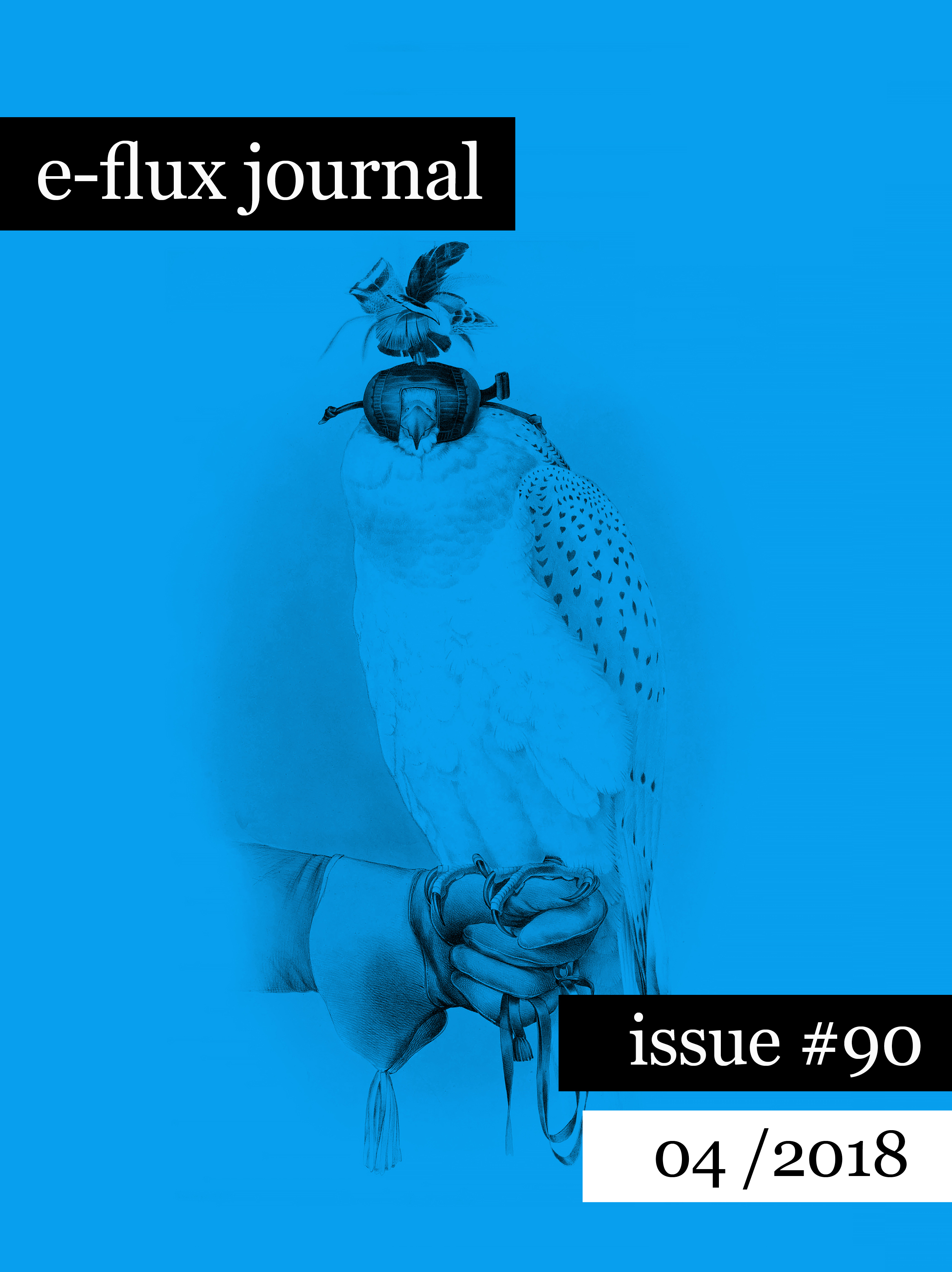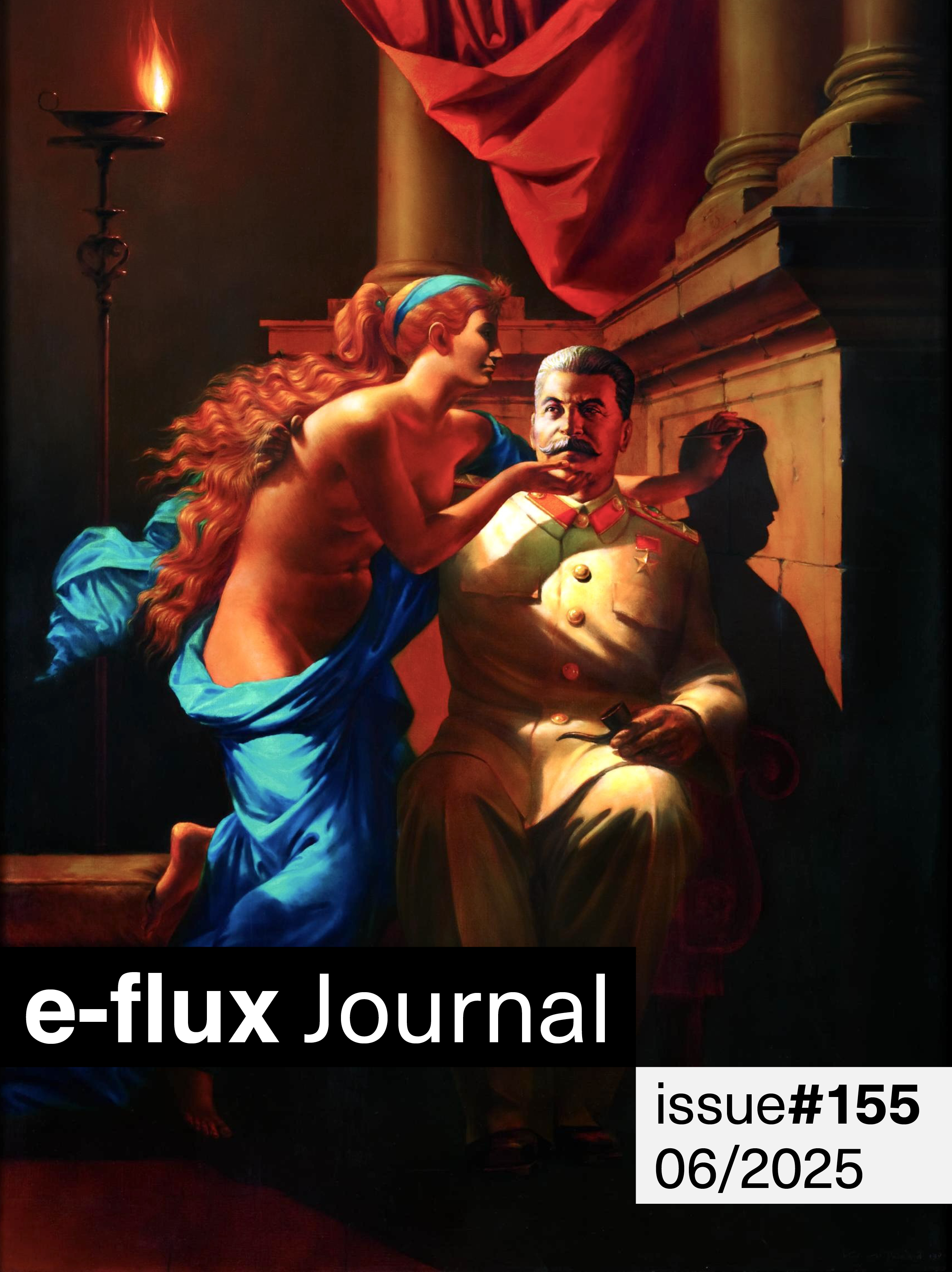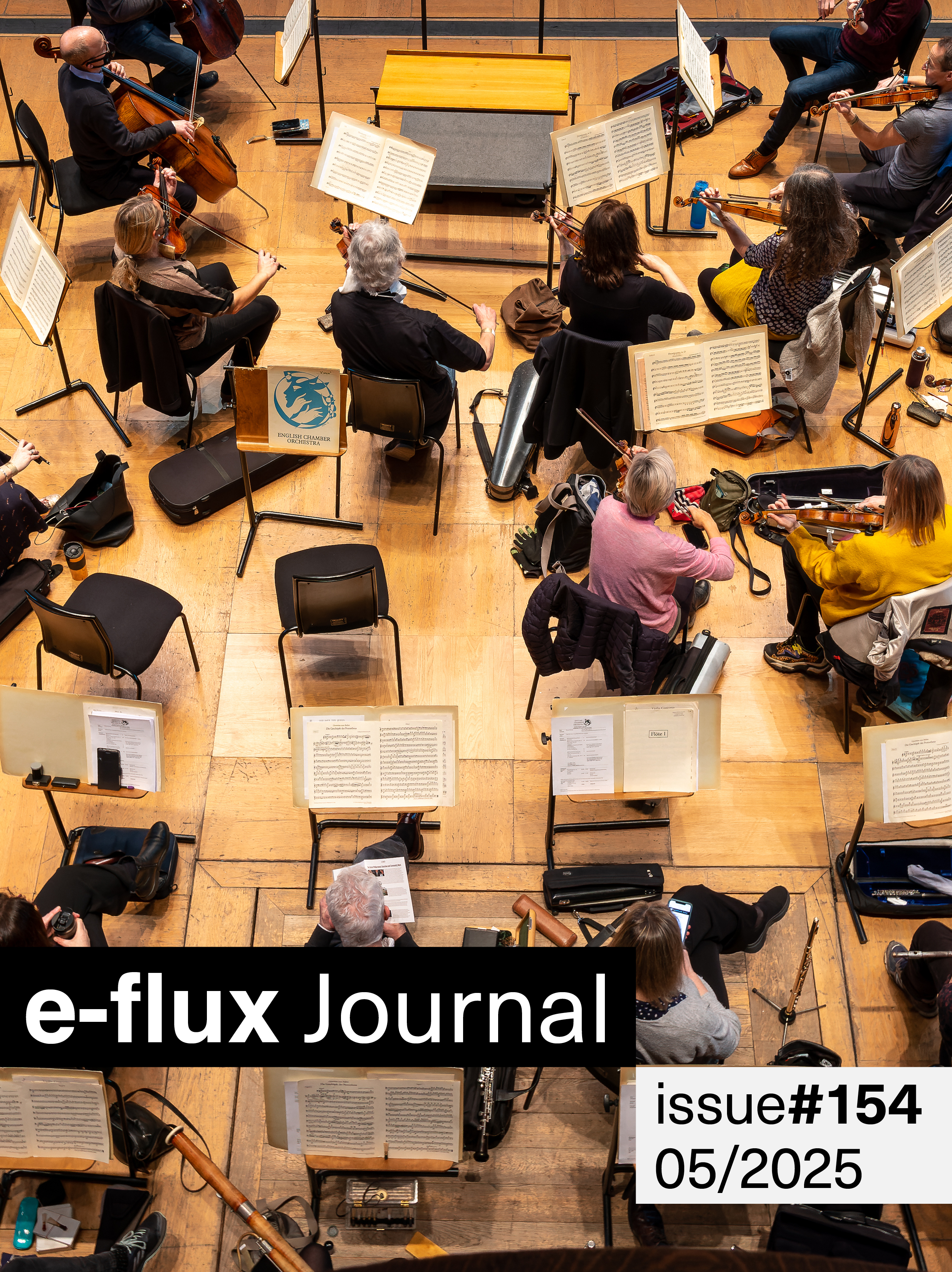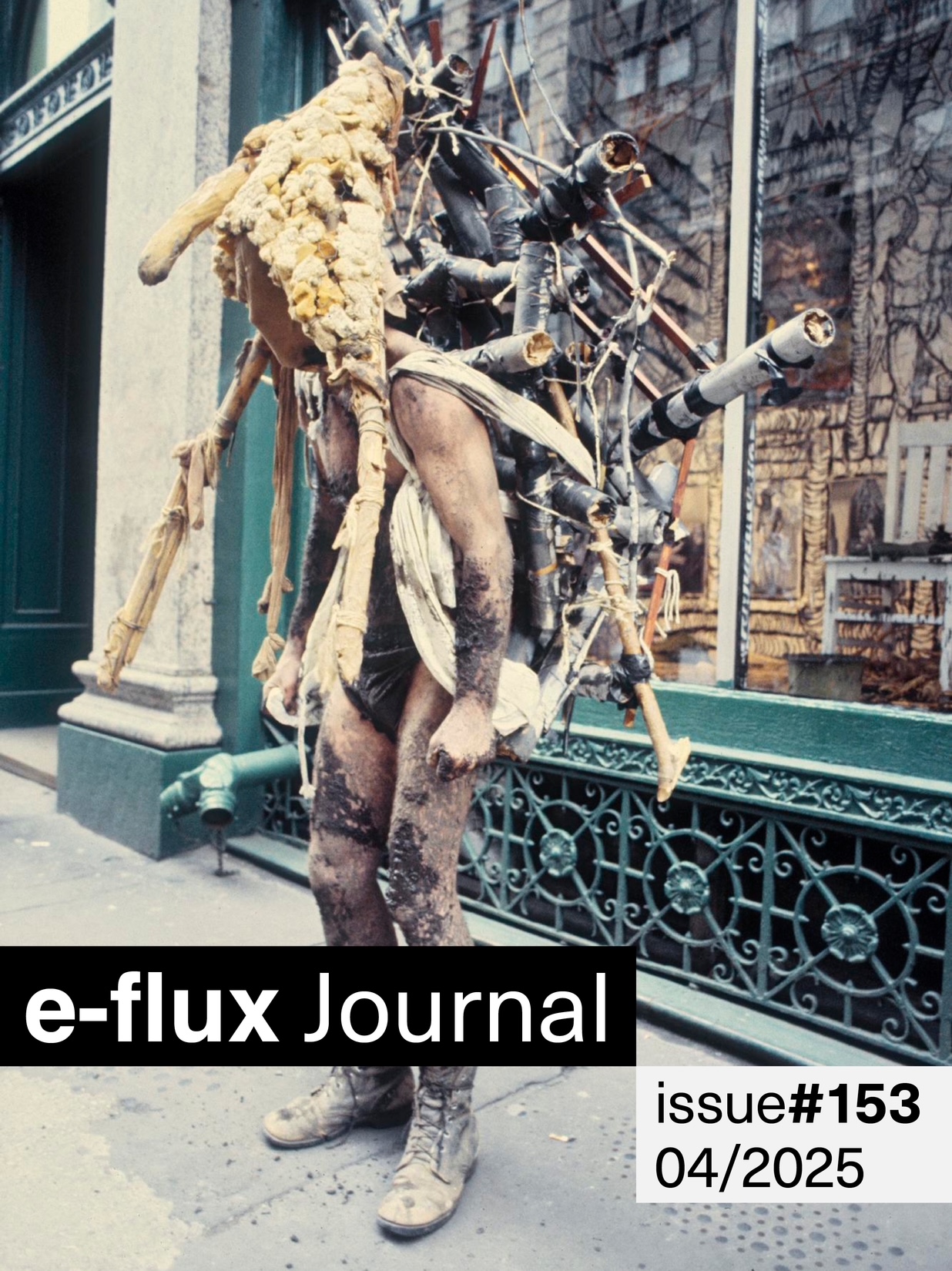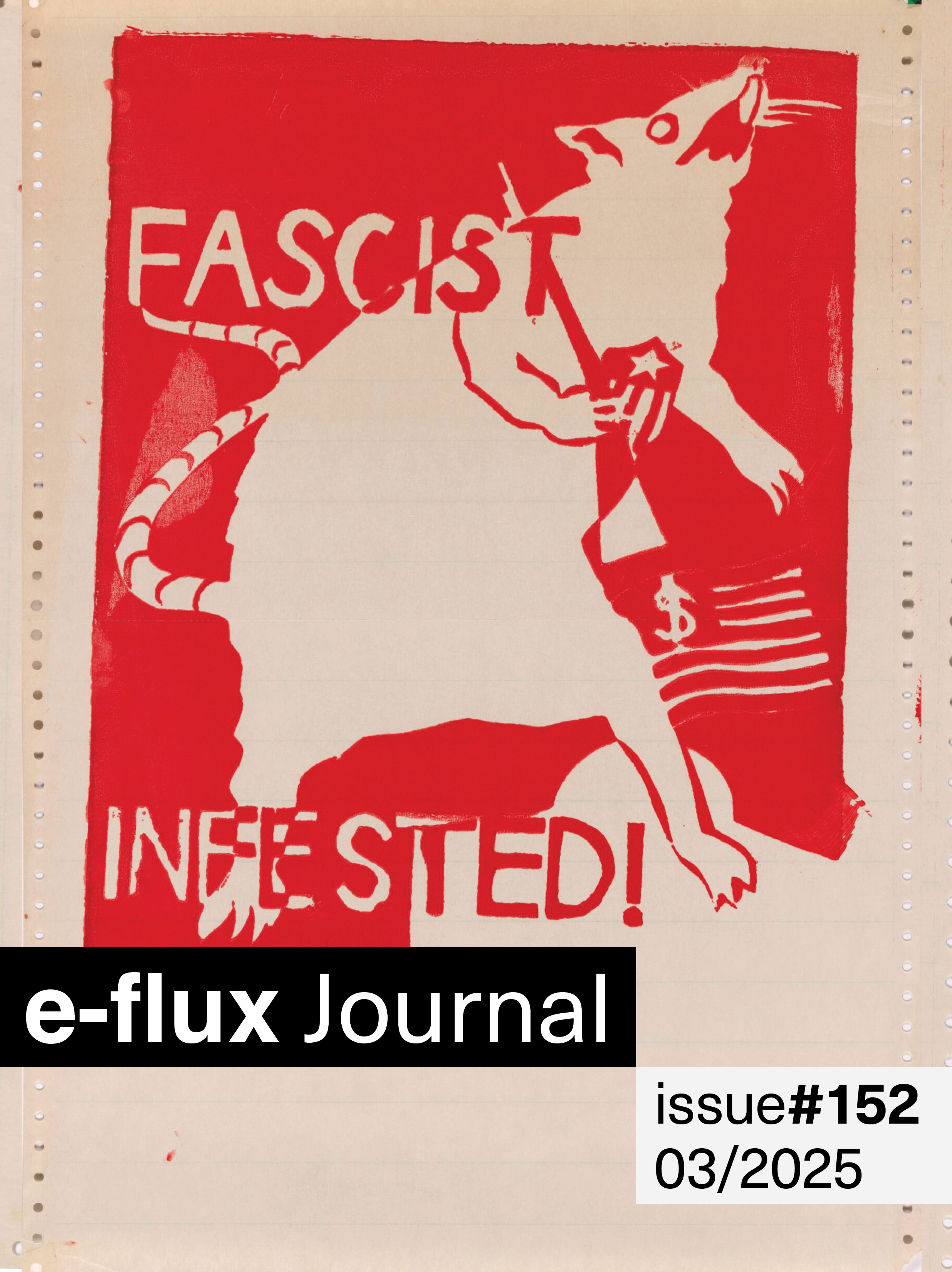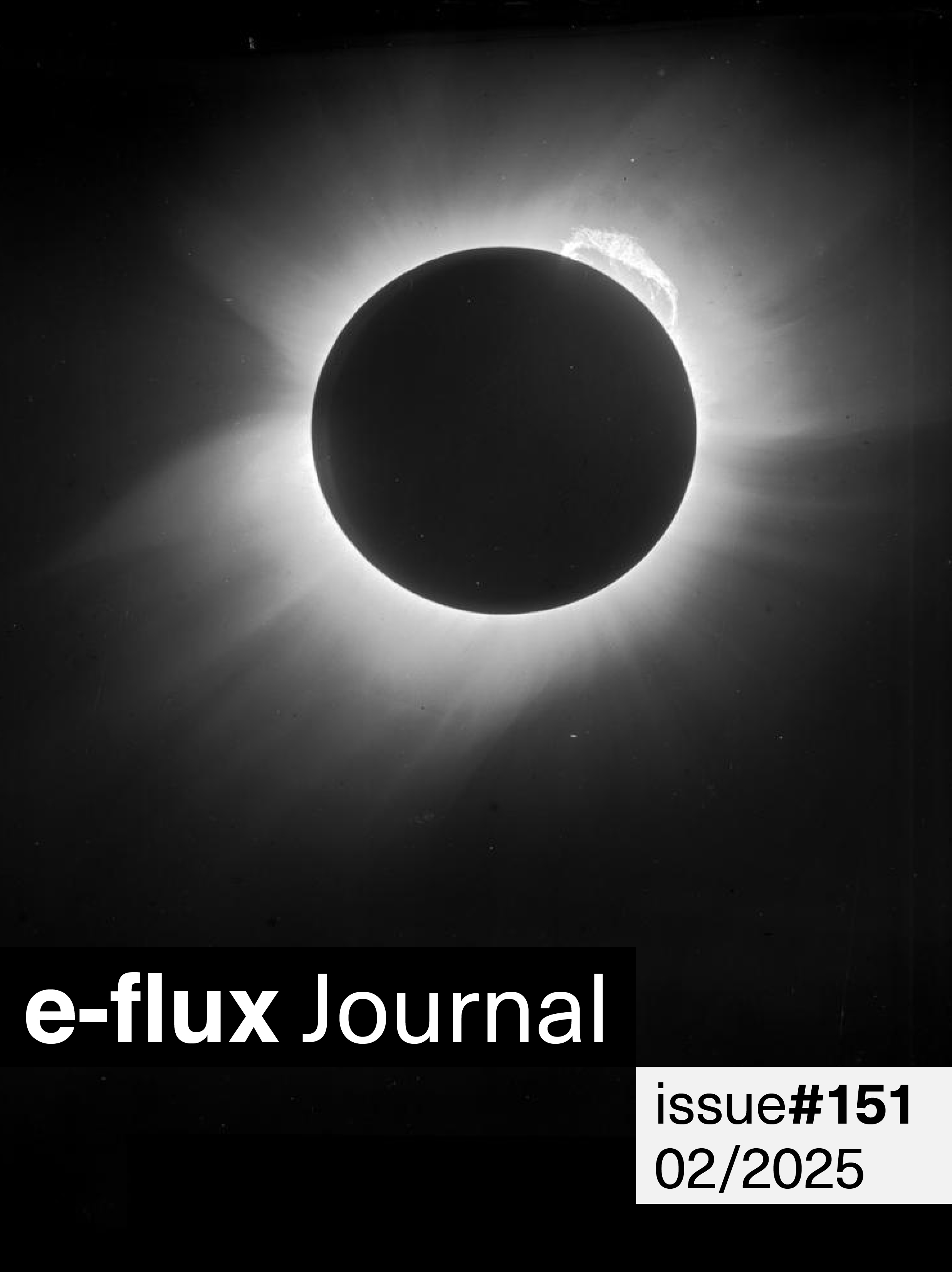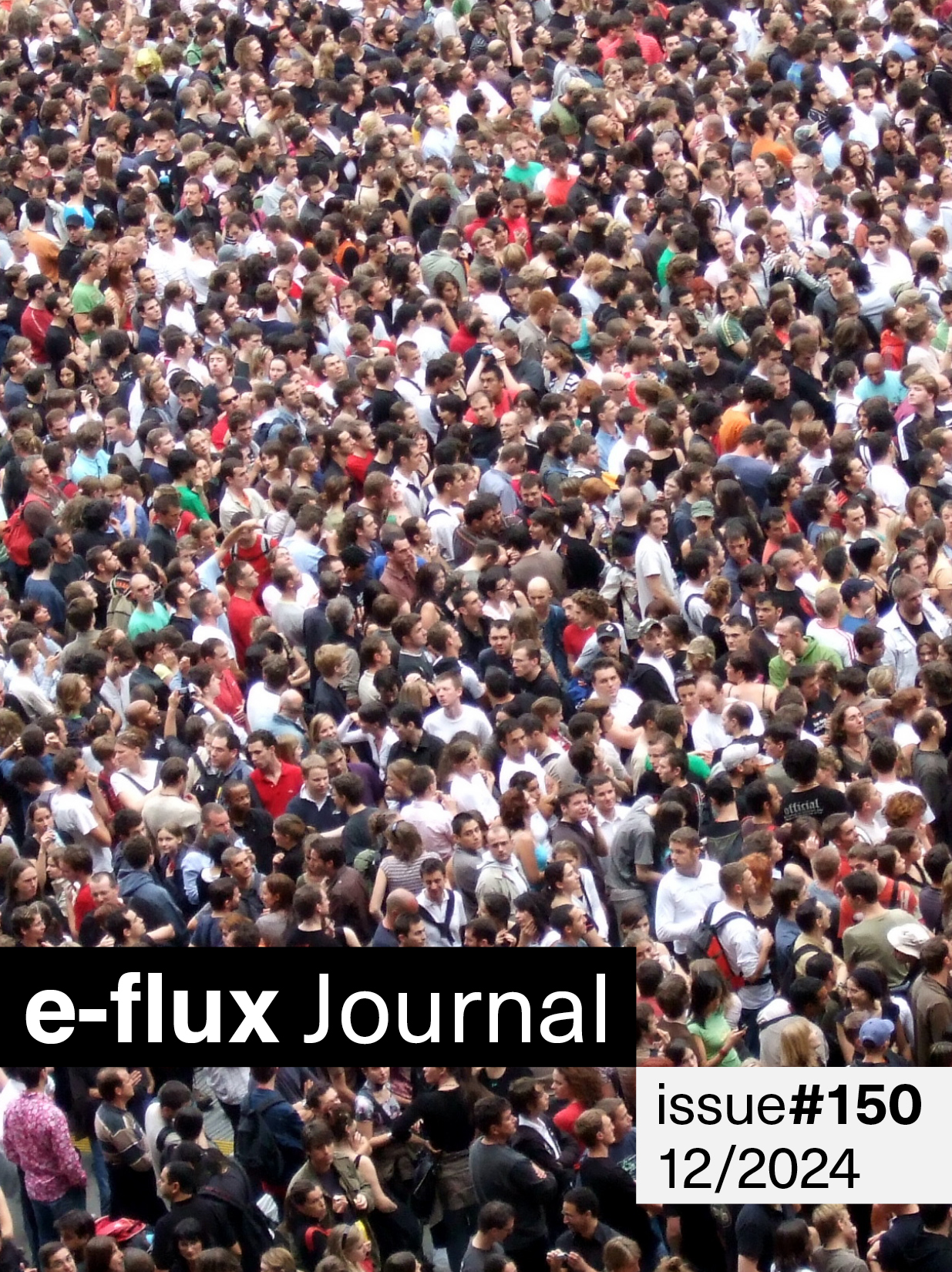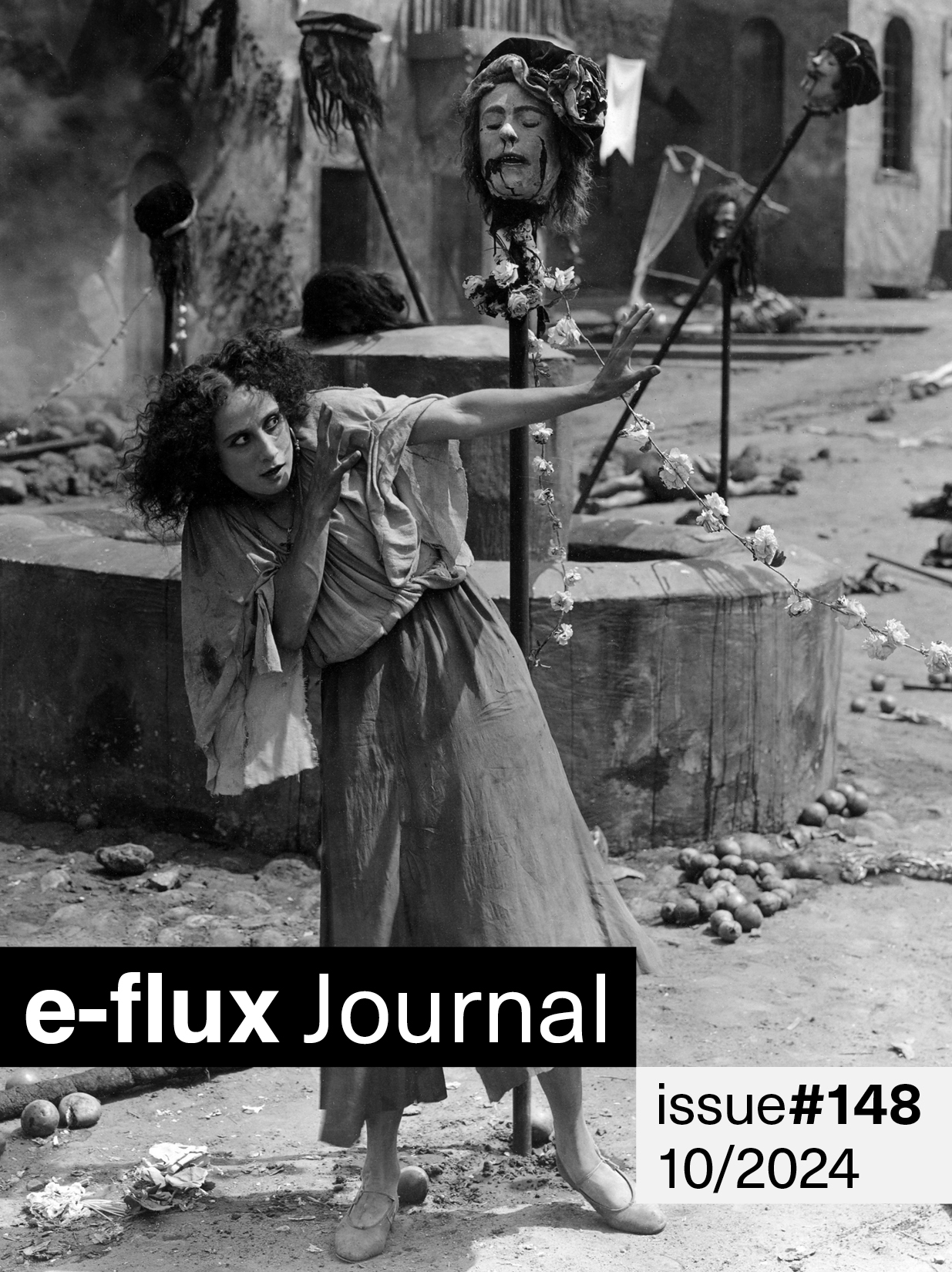e-flux journal issue 90: “Trade Markings”
Guest-edited by Vivian Ziherl
with Richard Bell, Aileen Moreton-Robinson, Wendelien van Oldenborgh, Rachel O'Reilly, Ho Rui An, Angela Mitropoulos, Yazan Khalili, David Kim, Elizabeth A. Povinelli, and Demian DinéYazhi’
In opening the book The White Possessive: Property, Power, and Indigenous Sovereignty (2015), Aileen Moreton-Robinson leads with an epigraph by Dennis Benjamin Moreton: “The problem with white people is they think and believe that they own everything.” In terms of a critique of the seven-centuries-long rollout and contestation of European dispossessive power, this citation is the alpha and the omega. It is incredibly hard to add anything that isn’t captured within its succinct analysis. Nevertheless, this special issue of e-flux journal goes to work amid the breadth of this statement—seeking greater insight into its truth and the counter-tactics therein through aesthetic study in particular.
The essays, dialogues, illustrations, and poetry in this issue are compiled in the context of Frontier Imaginaries, an art and research foundation established in Brisbane (Australia) and incorporated in Amsterdam (the Netherlands). It is specifically in this movement between the spatio/temporal compression of the settler colony on the one hand, and the predatory juridical mappings of merchant colonialism on the other, that the foundational relations of property—the endless toggle of propriety and expropriation—arise as a common denominator.
In practice, Frontier Imaginaries is a project that has found points of grounding in Brisbane, Jerusalem, New York, and Eindhoven, and it is in these oblique incidents that aesthetic study comes to the fore. The frontier, after all, offers a viewpoint that turns the European modern text on its side—revealing intricate and elided theaters of consequence that evade categorical reason.
In this work it is crucial to establish that the frontier is not a “border.” That is to say, it is not a contractual seam between two legal entities that share mutual recognition. The frontier is rather the threshold at which such a contractual space can no longer exert its jurisdiction.
The easiest way to dramatize that threshold is through territorial metaphors hailing an outer limit to a locus of power, e.g., the image of a “wild west” beyond the grasp of metropolitan law, or the “final frontier” of outer space and/or tech innovation. The limits of such contractual space are convoluted, however; they roll together and exist multifariously. Contractual failure can occur through incommensurabilites in the terms of agreement itself, for example.
The primal scene of the European modern agreement is neatly summarized in Hugo Grotius’s Mare Liberum (1609) as “trade supported by force of arms.” Here the potential “freedom” of any such trade is radically qualified by the violence inherent within “force of arms.” The greater title of the treatise that Mare Liberum is culled from—De Iure Praedae Commentarius (Commentary on the Law of Predation/Booty)—also calls out the need for a renewed vocabulary of standardized larceny, and cuts to the quick of Denise Ferreira da Silva’s notion of the European modern “Spirit of Possession,” a riff on Hegel.
As an advisor to the fifth edition of Frontier Imaginaries, Ferreira da Silva suggested the title “Trade Markings,” which also gives its name to this special issue of e-flux journal. Trade Markings signals the internally incommensurable demands of proprietary modernity under “Natural Law”: on the one hand the claim to trade marking as legitimate opacity, and on the other hand the enforceable transparency of frictionless exchange. This is the vremden handel or strange business of the Spirit of Possession.
This journal issue includes a large portion of artists’s writing, starting with a return to Richard Bell’s barnstorming 2003 declaration “Bell’s Theorem: Aboriginal Art—It’s a White Thing.” A reflection on the boom in markets for Australian Aboriginal art since the 1980s, “Bell’s Theorem” attacked the fundamental categories of colonial cultural value, resetting the terms of art history in Australia and more broadly. In a similarly rebellious spirit, Yazan Khalili’s I, The Artwork turns the tradition of conceptual art towards the context of occupation with a “Deed of Ownership and Condition of Existence” that codifies BDS (Boycott, Divestment, and Sanctions) conditions into the very being of the artwork. In dialogue with lawyer and critic David Kim, Khalili discusses the implications of I, The Artwork with regard to fundamental categories of profit, ownership, obligation, and aesthetic effect.
Artists Rachel O’Reilly, Ho Rui An, and Wendelien van Oldenborgh consider genealogies of proprietization in Australian, Singaporean, and Dutch turns. Demonstrating the aesthetic crises at the heart of environmental and colonial urgencies, O’Reilly takes the 1800s British-Australian legal innovation of Torrens Title as a case in point of the compositional violence of the property form. Ho examines the subjective governance encoded in financialized statehood. His take addresses the speed-scape of the road, and its accidental cinemas of the dashcam. Whereas movement is the principle of Ho’s study, van Oldenborgh focuses on distance, in an examination of a real-estate property in Amsterdam and its multiple lives as financial asset, office workplace, architectural heritage, and shelter to asylum seekers. Also moving through an analysis of filmmaking, van Oldenborgh pursues the “colonial-modern here-ness” and value structures of the modern city through the cinema of Alain Resnais, Glauber Rocha, and Pedro Costa.
Aileen Moreton-Robinson’s “white possessive” casts a long shadow across this journal issue. Her essay included here, “Bodies That Matter on the Beach,” reads the racialized body politics of Australian beach culture against the warrior stance of artist Vernon Ah Kee. Elizabeth A. Povinelli likewise contributes a meditation on the proposal of a frontier point of analysis with a searching critique of critiques, “Horizons and Frontiers, Late Liberal Territoriality, and Toxic Habitats.” Angela Mitropoulos also reads the frontier through her essay “Art of Life, Art of War: Movement, Un/Common Forms, and Infrastructure.” Here Mitropoulos takes modern dance as a locus to examine ideals of movement inherent to proprietized relations, captured against the backdrop of emergent European fascism.
The issue closes with a fragment of poetry by artist and founder of R.I.S.E.: Radical Indigenous Survivance and Empowerment, Demian DinéYazhi’. Pressing his words forward against the reader, DinéYazhi’ undercuts the dispossessive plane of the American imaginary with a text untethered from the possessive comma, and indeed from typographic punctuation altogether.
—Vivan Ziherl
Richard Bell—Bell’s Theorem: Aboriginal Art—It’s a White Thing!
Aboriginal Art has become a product of the times. A commodity. The result of a concerted and sustained marketing strategy, albeit, one that has been loose and uncoordinated. There is no Aboriginal Art Industry. There is, however, an industry that caters for Aboriginal Art. The key players in that industry are not Aboriginal. They are mostly white people whose areas of expertise are in the fields of Anthropology and “Western Art.” It will be shown here how key issues interrelate to produce the phenomenon called Aboriginal Art, and how those issues conspire to condemn it to non-Aboriginal control. Like some voracious ancient God, Western Art devours all offerings at will. Sometimes the digestion will be slow and painful.
Aileen Moreton-Robinson—Bodies That Matter on the Beach
In the nineteenth century, surf bathing was performed exclusively by white males, but it was not a predominant part of beach culture because the Police Act 1838 restricted swimming to the early hours of the morning and preferably on nonpopular beaches. The public display of the white male body was perceived to offend moral sensibilities current at the time. It was not until the early twentieth century that surf bathing became a part of modern beach culture, due in part to the shifting codes of Victorian morality and increased control of the sea and the surf.
Wendelien van Oldenborgh—Asset as Set: Filmmaking in Relation to a Certain Realness of Site
In the spring of 2016, We Are Here, a group of people who had been refused official stay in the Netherlands but could neither return to their countries of departure nor go anywhere else, squatted Tripolis 200, one of the three buildings of the complex, for roughly three weeks. Ironically, until two years earlier, this part of the complex had been occupied as the municipal office of South Amsterdam through which (accepted) citizens passed to register, get married, and pick up official documents.
Rachel O’Reilly—Dematerializations of the Land/Water Object
During normotic peaks of approval phases of settler-colony mining booms, “artist impressions” of mega-mine proposals are photoshopped up at unprecedented rates and scales. Weaponized images of dignified-looking but no longer collectively-bargaining laborers, exaggerated job figures, fetishized New Machines, and particularly pernicious laminations of corporate-sponsored settler household reproduction placehold new industry forms of extraction. The perversions of prospective accounting given for “environmental assets”—for example, soil and water—force a rereading of finance through colonial legacies that limit the imagination of mattering. Between the slave ship and the container ship, the story of Australia’s particular mercantile-era contribution to the arsenal of global capital, in making the concept of land fully fungible, generates extra-aesthetic analytics by being retold.
Ho Rui An—Crisis and Contingency at the Dashboard
Put bluntly, the point is to interpret and act on the world, but never to change it. The contemporary turn towards the “innovative state” thus cannot be taken plainly as some counter-hegemonic project to prove the state’s ability to achieve the social optimization that neoliberals expect from the free market. Instead, in testing, experimenting, and reinventing itself, the state too often displaces existing functions of social redistribution through its new role of reengineering a defunct system requiring no more than an upgrade.
Angela Mitropoulos—Art of Life, Art of War: Movement, Un/Common Forms, and Infrastructure
The Serpentine Dance hinted at an exoticism, but was often read as sublimation in the chemical sense: a phase transition between a solid body and a gaseous apparition, without quite passing through a liquid state. If the Serpentine Dance emerged in the turbulence of transatlantic crossings and the ports of empire, its characterization as a rapid circuit from a fixed body to air would treat liquescence as an inclination or step toward the figural, a referential tendency toward the affirmation of ideal forms rather than delight in afformation.
David Kim—I, The Artwork: A Conversation with Yazan Khalili
Can the artwork itself boycott the institution? Can the work be taken seriously? Does it need me, the artist, to speak on its behalf, or can it speak in a very clear way itself—in the most didactic way possible? There’s this moment when they tell you not to do didactic works, and then you say, maybe it has to be as didactic as possible to question this kind of politics. It comes from the circumstances: the growth of the art market at some point, and my becoming connected to some aspects of this art market. What kind of contract should there be? Should there be a contract at all? Should you play with this contract to produce something with which you can speak to the art market?
Elizabeth A. Povinelli—Horizons and Frontiers, Late Liberal Territoriality, and Toxic Habitats
Two imaginaries of space have played a crucial role in the emergence of liberalism and its diasporic imperial and colonial forms, and have grounded its disavowal of its own ongoing violence. On the one hand is the horizon and on the other is the frontier. These two spatial imaginaries have provided the conditions in which liberalism—in both its emergent form and its contemporary late form—has dodged accusations that its truth is best understood from a long history and ongoing set of violent extractions, abandonments, and erasures of other forms of existence, and have enabled liberalism to deny what it must eventually accept as its own violence.
Demian DinéYazhi’—An Infected Sunset (Excerpt)
I imagine I am one of my ancestors overlooking Tséyi´ watching all the corn fields ablaze and then someone hits the fastforward button and then I’m suddenly standing on the washington side of the columbia river gorge watching a forest fire light up the sky in the black womb of nite
